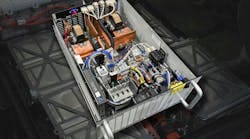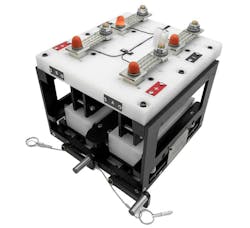How Automation is Unlocking Efficiency and Innovation in BEV Development
What you’ll learn:
- How BEV automation has driven new advances.
- What testing capabilities and infrastructure are necessary to handle next-generation, high-powered electric batteries?
- How sophisticated data analysis and machine learning can optimize electric battery testing and production.
- What strategies can synchronize production and testing cycles to ensure efficient and high-quality BEV battery manufacturing?
The requirement for automation in battery-powered electric vehicles (BEVs) has led to unprecedented advances in the development of automotive components, systems, and services. As sales growth of BEVs has slowed in the United States due to consumer hesitancy over limited range and the cost of replacing the electric batteries, car manufacturers face growing pressure to develop improved electric batteries.
Testing in the product development cycle and production is fueled by data collection and analysis of performance. Automation in both phases is essential to achieving safe, reliable, efficient battery design iteration and production. Advanced systems integration (SI) ensures optimal and accurate functioning of all components and is vital to achieving automation’s benefits in BEV testing and production.
Changes in EV Testing for Improved Battery Performance
The highly competitive BEV market fuels an intense drive for rapid R&D on improved EV batteries that address consumer concerns like range and replacement costs. Manufacturers are motivated to develop batteries with higher energy density and longer lifespan, leading them to push for testing even more powerful batteries. This pursuit of next-generation, high-powered electric batteries brings critical changes in testing capabilities and infrastructure (see figure).
The test facility may need infrastructure and equipment upgrades to handle significantly higher power demands, reaching into the megawatt range. New sensor technologies have been developed to handle higher voltage and amp requirements safely. Standards are constantly changing, so it’s crucial for automated test systems to be designed with the flexibility to add or swap out new sensors and instrumentation capabilities that can handle increasing voltage or amp standards.
In addition to scaling up power-handling capabilities, there’s greater demand for increasingly precise measurements and tighter tolerances in EV testing. More accurate and sensitive sensors generate far richer and more valuable datasets than were previously possible. This granular test data allows for deeper analysis and insights, accelerating the feedback loop for faster product design iteration.
The integration of electrochemical performance analysis directly into the R&D program is becoming more frequent. Instead of conducting electrochemical impedance spectroscopy (EIS) disconnected from the test stand, these tests can now be integrated into data-acquisition (DAQ) and controls systems.
>>Download the PDF of this article and check out the TechXchange for similar articles and videos.
Such integration allows for the collection of near real-time data on the battery’s chemical performance. It can be evaluated holistically with the mechanical and electrical data rather than assessed separately after testing is completed.
Greater Data Analysis Expectations in Electric Battery Testing
Electric battery testing is more complex today because the expectations of the testing have shifted the goal away from reaching a pass/fail conclusion. The new goal is to collect as comprehensive a scope of data as possible to enable substantive analysis that reveals insights to increase battery performance and optimize EV testing and production.
Deep test data analysis could uncover opportunities to improve the battery’s core characteristics, such as energy capacity, charge and discharge rates, and thermal stability. On the production side, more sophisticated automated data collection could identify ways to increase throughput, reduce fabrication costs, or streamline end-of-line testing.
The challenge is navigating the complex science to determine the most valuable information and the best way to acquire it. More sophisticated data mining and analysis, e.g., machine learning, can reveal previously unseen details that could be used to optimize testing and production. For example, with the right information collected, analysis of production data may identify a battery sub-component that’s most likely to fail based on sensor data signatures.
All of the data from multiple sources is integrated into a single data analysis and management system for manufacturers to realize these benefits. Yet, the interconnected nature of these systems presents difficult hurdles. A minor issue in one subsystem could corrupt data integrity across the wider system. For example, for the cooling water system used during battery-pack testing to operate properly, it’s vital for the cooling system, DAQ, and battery cycler to work in tightly integrated harmony to produce valuable, usable data for analysis.
Transitioning BEV Battery Designs from R&D to Production
As battery designs move from R&D to production, the critical metrics shift. Instead of refining individual components, optimizing throughput and volume output is imperative. This increases the necessity for automation to achieve these metrics safely while maintaining quality standards. The scope gap requirements become more stringent to meet high-volume production demands.
It’s critical for every subsystem in the production process to be tightly integrated and choreographed to work in complete synchronization. For instance, robotic assemblies designed by a systems integrator must align battery components within tight tolerances, ensuring consistency and quality across all units. Ensuring seamless integration requires clearly defined owners for every task across all systems with no gaps in coverage, as well as thoroughly defined interfaces among all of the owners’ tasks.
The logistics of production-line design to meet throughput requirements also create design challenges, as end-of-line assembly and quality testing often can’t be accomplished as quickly as lines produce parts.
Adjustments to the line are made to maintain efficiency. This usually involves careful planning and calculation to ensure testing capacity aligns with production goals. For example, designing battery discharge systems that meet energy metrics within specified timeframes requires precise coordination to prevent bottlenecks and maximize throughput.
When testing cycle times can’t keep pace to meet throughput requirements, the systems integrator has two general strategies to balance these differing step rates: the batch size tested at one time can be increased, or parallel testing lines can be added to increase the total throughput.
For example, if a manufacturer wants to produce 10 parts per minute before testing, and it takes one minute to test each part, the production line will need 10 test systems to achieve the production rate. Calculating and designing efficient part flow to synchronize these production and testing cycles is critical to safely producing a sufficient volume of electric batteries that meet quality standards.
The Compounding Benefits of Integrated Automation
The enhanced data-collection capabilities and subsequent analytics derived from automation in the testing and production phases have elevated the feedback loop to produce more rapid innovation, more efficient processes, and, ultimately, a superior product. The challenge is designing automated systems that collect the most valuable data accurately and reliably while avoiding overly narrow designs that may hinder future modifications or require costly upgrades.
A systems integrator knowledgeable in BEV testing and production can optimize the automation and integration of all subsystems to facilitate development in this highly competitive and rapidly changing market, ensuring that the system remains future-proofed for evolving needs.





